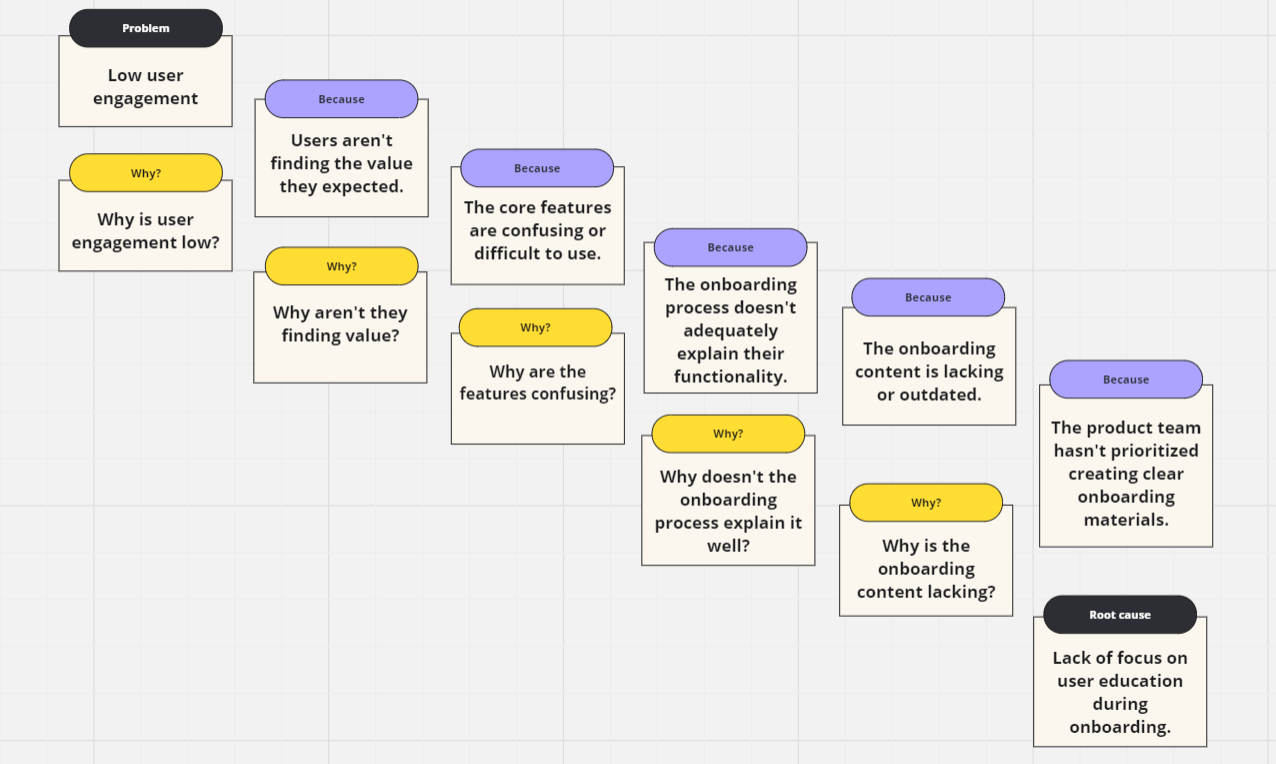5 WHYs Framework for Product Managers
This is a great framework that most of the product managers use to find root cause of product problems and rectify them.
👋🏻 Hey,
Welcome to the #3rd edition of the Product Space Newsletter, where we help you become better at product management.
Let's talk about one of the most important things in a product manager’s day-to-day job - getting to the bottom of things, product problems to be exact. We all deal with them, from low user engagement to pesky bugs. But how often do we really understand the core reason behind the issue?
That's where the 5 WHYs Framework comes in. It is a tool used by most product managers to peel back the layers of a problem and get to its root cause.
It's a simple yet powerful technique that helps move beyond surface-level issues and identify the underlying factors causing them.
How it works
Start with the problem: Identify the initial issue you're facing. It could be anything from low user engagement to a bug in your product. Is it a drop in user sign-ups? A confusing feature? Be specific!
Ask "Why?" five times: For each answer you get, ask "Why" again to dig deeper. Don't stop at the first explanation; keep questioning until you reach the core reason behind the problem.
For Example: Let's say user engagement is low. Here's how the 5 Whys might play out:
Why is user engagement low? - Users aren't finding the value they expected.
Why aren't they finding value? - The core features are confusing or difficult to use.
Why are the features confusing? - The onboarding process doesn't adequately explain their functionality.
Why doesn't the onboarding process explain it well? - The onboarding content is lacking or outdated.
Why is the onboarding content lacking? - The product team hasn't prioritized creating clear onboarding materials.
See where this is going? By the fifth "Why," we've identified that the root cause of low engagement is a lack of focus on user education during product onboarding.
How it benefits Product Managers
This framework equips you to tackle problems head-on and make smarter decisions like:
To uncover root causes: The 5 WHYs help move past symptoms and identify the fundamental reasons behind problems.
For better decision-making: By understanding the root cause, product managers can make more informed decisions about solutions and improvements.
Improved problem-solving: This framework encourages critical thinking and a systematic approach to tackling product issues.
In collaboration: The 5 WHYs can be used in group discussions to get various perspectives and reach a deeper understanding of the problem.
Best practices for adopting this framework
To maximize the effectiveness of the 5 WHYs, there are some key practices to keep in mind:
Focus on open-ended questions: Instead of yes/no answers, ask questions that prompt discussion and exploration of the issue.
Challenge assumptions: Don't take initial explanations at face value. Encourage critical thinking to ensure you're not missing anything.
Listen actively: Pay close attention to the reasoning behind each answer. This will help you formulate better follow-up questions.
Iterate and refine: The 5 WHYs is an iterative process. As you uncover new information, revisit earlier answers to see if they need refinement.
Collaboration is key: Involve stakeholders from different areas (design, engineering, etc.) This allows for a more comprehensive understanding of the problem.
When to use this Framework
Here are some situations where it can be particularly effective:
Understanding user behavior: When user feedback indicates confusion or dissatisfaction, use the 5 WHYs to understand the underlying reasons.
Analyzing product issues: Is a feature not performing as expected? The 5 WHYs can help pinpoint the root cause behind bugs or functionality problems.
Making data-driven decisions: Don't just react to data; use the 5 WHYs to understand the "why" behind trends and user behavior.
Limitations of the 5 WHYs Framework
While it’s a valuable tool, it's important to be aware of the following considerations:
Not a one-size-fits-all solution: Complex problems might require a combination of techniques for a complete picture.
Beware of confirmation bias: Our existing beliefs can influence the direction of questioning. Be mindful of this and strive for objectivity.
Limited to uncovering "why," not "how" to fix: While the 5 WHYs identifies the root cause, it doesn't necessarily provide solutions. You'll need additional brainstorming or problem-solving techniques to develop solutions.
So, the next time you face a product mystery, remember the 5 WHYs framework! It's a simple but powerful tool that can help you dig deeper and uncover the root cause of problems and build better products.
That's a wrap for today.
Have you used a creative approach to understand a user behavior or product challenge? Got a success story or a handy tip to share? We want to hear from you! Share your experience in the comments below or reply to this email.
Until next time, keep innovating, keep iterating, and above all, keep being awesome.
Cheers!
Product Space





